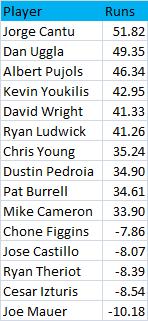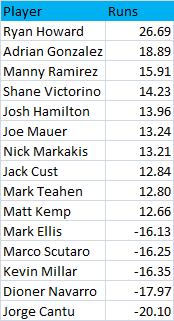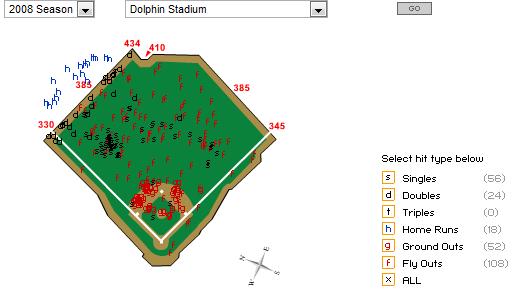
| Touching Bases | February 24, 2009 |
With apologies to Dave Studeman, whose batted ball leaderboards on The Hardball Times are always must reads, I decided to try a similar data presentation, breaking up batted ball stats by fields of play instead of by type. Using linear weight run values, I developed lists showing who the most productive players were in 2008 when pulling the ball, taking the ball back up the middle, or going to the opposite field.
Value of Pulled Batted Balls

Every one of the top ten players when it came to pulling the ball happened to bat right-handed, which can be explained by their relative advantage when hitting ground balls. Righties who pull grounders force longer throws than lefties who pull grounders. These players are mainly fly ball hitters. In the case of switch-hitters like Chone Figgins, I combined their pulled/center/opposite field stats from each side of the plate, so right-handed balls to left are added to left-handed balls to right to come up with pulled batted balls.
Jorge Cantu and Dan Uggla—who would’ve thunk? Uggla is a former Rule 5 pick and Cantu spent time last year in two different minor league systems before both found their rightful spots on the Marlins. I’d have to attribute their appearance on the leaderboard to coincidence. Dustin Pedroia and Kevin Youkilis, on the other hand, are given a bit of an extra push, as both are clearly aided by the green monster. Pedroia might be the perfectly suited player for Fenway. Just check out his home run chart. He has yet to hit a 400-foot homerun in his career. You have to wonder whether he’d be the MVP outside of that park, as it would certainly be a challenge to find a voter who checks park-adjusted stats.
I don’t think I ever expected to see the universally beloved Joe Mauer on the bottom of any list, but he gets murdered by pulled groundballs. Only three of his nine long balls went to right field in 2008, as he unfortunately never developed the 20 homerun power people were hoping for. Chone Figgins, Ryan Theriot, and Cesar Izturis all had one homerun apiece last year, while Castillo tallied six, so it appears that a minimal amount of power is necessary to be successful pulling the ball.
Value of Center Field Batted Balls

It’s interesting that the top six players on this list bat right-handed. But the bottom four players do too, so that would suggest that the trend of righties is random. It’s tough to choose between the hitters best at pulling the ball and best at going up the middle, but I’m siding with the latter set of players. I’d classify the first set of hitters more as homerun hitters and the second set as line drive types. Pedroia appears at the bottom of this list, likely because in Fenway he doesn’t derive the same benefit from his fly balls to center as he does to the left-field wall. He picked up just three hits on 73 center-field flies.
Value of Opposite Field Batted Balls

What Mauer lacks in pulled balls he makes up for with his approach going the other way, as he is the only catcher to appear on a leaderboard. Nick Markakis, Matt Kemp, and Manny Ramirez all show up as top center and opposite field hitters. These guys are at times described as "pure" hitters, and there's why. I'd presume each one is quite talented at going with the pitch.
Without trying to sound hyperbolic, I have to ask: is Ryan Howard the greatest opposite-field power-hitter ever? His 2006 and 2008 seasons in which he crushed 25 and 20 opposite-field blasts, respectively, are the only years in the last four in which any player has hit more than even 15 homers to their weak side. Howard does have his opposite-field numbers skewed by his groundball run value, which is likely only positive due to the vacated side of the infield.
Analyzing Howard’s trends piqued my interest in a specific batted ball type and location: pulled groundballs. There were seven players who cost their team 20 runs on pulled grounders: Mark Teahen, Prince Fielder, Adrian Gonzalez, Ryan Howard, Jimmy Rollins, Casey Kotchman, and Carlos Delgado. Several of these players do indeed receive the defensive shift, but I immediately noticed one of these names is not like the other. Jimmy Rollins sticks out like a sore thumb. He’s a switch-hitter, and as such is the only non-lefty to appear on the list. He is far and away the fastest player in the group and an absolutely awesome baserunner, but he apparently wasn’t able to make the most of his speed last year when he put the ball in play, compiling a well below league average 19% hit rate on grounders and legging out a single bunt hit in seven attempts.
Adrian Gonzalez might actually have power that approaches Howard’s but we’ll never know until he gets out of Petco. At the other end, one thing’s for certain: pitchers need to find ways to prevent Cantu from pulling the ball. Here's what the spray chart for Cantu—perhaps the best pull hitter and worst opposite field hitter in the game—looks like.

Comments
Awesome stuff, Jeremy. And apology accepted.
Posted by: studes at February 24, 2009 4:26 AM
Thanks, Studes.
Posted by: Jeremy at February 24, 2009 12:39 PM
Excellent job here, love seeing interesting things like where Mauer is (not very surprising, either).
I also had the same initial conclusion as you regarding the two pulling Red Sox players...before I even read your analysis, I said "Fenway must be a help, haha". However, upon further review, I think you may have been premature in your conclusion. Let's break it down by player:
Youkilis- When you split his stats, the thing that jumps out at me is his VASTLY better BB/K ratio at home...not exactly the kind of thing Fenway creates. Perhaps he sees the ball better, perhaps he's just more mentally confortable at home, perhaps his hot streaks just coincided with his home stands, but I don't think the wall was everything there.
Pedroia- More home runs on the road puts a dent in the conclusion, right?
Both- I think this is more the results of the fact that both hitters are very much pull hitters, and when they pull they often get hard liners that are tough to turn into outs (one of the reasons Pedroia had that tough start to his career is because EVERYTHING went to a fielder). Not sure if this applies to most hitters, but it struck me that both guys had very, very few pulled fly ball outs, and far more opposite field outs. I think the bottom line is that Pedroia is a pure pull hitter, and that his opposite field balls are more accidents or bad reads/swings, so much of his production comes on the pull...and that while Youkilis will go the opposite field, his fly balls there all lack pop and tend to be easy outs.
Never be too quite to call for "ballpark adjustments". I have also long been against using ballpark adjustments in an individual award arguement, because that assumes that all hitters are affected the same by ballparks, and I disagree with that. For example, I believe that Todd Helton benefitted far more than the average hitter from Coors, and that his adjustments still overestimated his value. On the other hand, Nomar Garciaparra of the 1990s would have his numbers reduced after adjustment by Fenway, but I think the ballpark actually hurt his numbers (many home-run bound smashed liners of his would end up simply denting the monster for a lousy single or double). Not to say that we shouldn't try, but when we're really trying to break down the value of a hitter, I think we owe it to the player to look very closely and avoid lump assumptions, or else make no attempt to adjust at all.
Posted by: Peter at February 24, 2009 2:00 PM
Peter, thanks for the comment.
I agree Youk and Pedroia aren't products of their park, but right-handed fly ball hitters on the Sox can't help but derive an advantage from the green monster.
For reference, players hit about .250 points higher and slug some 1.000 points higher on pulled fly balls than opposite field fly balls. So yeah, Youk and Pedroia fit the norm in terms of their fly ball profiles, though they're obviously better hitters than most.
Parks certainly need to be adjusted differently for individual players and individual components. I believe park factors work better on a team-by-team basis rather than player-by-player basis. Youkilis would hit a whole lot better to center field outside of Fenway. And good catch on Pedroia. I wonder at what other parks he was able to hit the rest of his cheapie homers. I kid.
As for saying that Fenway hurts line drive hitter's production, I strongly believe that's a myth, as the evidence simply doesn't back it up.
This is a great article by Greg Rybarczyk, the man who runs the great hittracker web site: http://www.hardballtimes.com/main/article/home-run-park-factor-a-new-approach/. And here's another good link that shows that Red Sox righties are slightly aided by the wall: http://docs.google.com/Doc?id=dfvdvsgn_26f49mrgk6.
I feel confident in saying that Fenway has aided Youk and Pedroia when they pull the ball in the air.
Posted by: Jeremy at February 24, 2009 2:47 PM
Well, Peter, Fenway is a Questec park. I'd be curious as to what Youkilis's BB/K ratio is in the other Questec parks.
I'm pretty sure I remember Sox TV analyst Jerry Remy commenting, at one point last season during the first game of a homestand, something to the effect that the Sox were glad to be back where they think what's a strike and what's not will be consistent.
Guys like Youkilis build their games around consistent strike zones from umps.
Posted by: James T at February 24, 2009 4:38 PM
Interesting point, James. Most players do play better at home simply because they're at home, but I never considered umpires differing park to park. There probably is something there. All stadiums do have the pitch f/x system in place, so I'd imagine they use the same data for Questec, but I'm not positive. I'd love to know what's behind Youk's change in approach with regards to the strike zone, as since 2005, his swing percentage on pitches out of the zone has risen from 11.5% to 15.1% to 17.4% to 22.3%
Posted by: Jeremy at February 24, 2009 5:01 PM
Wow -- what a great chart. It is one thing to say he pulls the ball.. another to show that he didn't put a single ball out to deep right.
Posted by: Jeff at February 25, 2009 11:32 AM
Good stuff. Makes my through the roof respect for Joe Mauer as a baseball player reach up to the sky.
Posted by: Joe at February 25, 2009 1:46 PM
Thanks Jeff. Cantu didn't even come close. Though that is only his hitting chart at home, Over the course of the year, he had only two opposite field hits on opposite field fly balls.
Joe, Mauer's great. I'm still holding out hope he can hit for some more power. He averaged 400 feet per homer last year, so probably has the raw power to do it, but he hits so many line drives he doesn't get enough loft on most hits. Plus, the baggy in right might hurt his output.
Posted by: Jeremy Greenhouse at February 25, 2009 4:59 PM
I wonder how much park factors play a part in this. Petco for example has a history of heavily supressing homeruns for left handed batters but is slightly advantageous for right handed batters, therefore that might lead to Adrian Gonzalez' opposite field prowess.
vr, Xei
Posted by: Xeifrank at February 27, 2009 12:20 PM
Xei,
I didn't adjust for park factors, and they certainly do play a huge role, as I noted with Pedroia and Youkilis. I didn't know Petco was at all beneficial to balls to left, but the numbers bare that out, so thanks for making note of it. My hunch would be Colorado has the biggest effect on batted balls, except that Holliday is the only Rockie I see on a leaderboard, and that's on balls to center where there's a crater in Coors. Also, I read somewhere that LA was a really hitter-friendly park to Manny.
Posted by: Jeremy Greenhouse at February 27, 2009 3:46 PM
Somewhere? :-)
You read it right here in a guest column by Hit Tracker's Greg Rybarczyk.
http://baseballanalysts.com/archives/2009/02/2009_projection.php
I hope Manny Ramirez re-signs with the Los Angeles Dodgers for 2009, because Dodger Stadium is an absolutely perfect place for him to hit ... Manny’s swing, particularly his phenomenal power to center and right-center field, is ideally suited for the dimensions and environmental conditions of Dodger Stadium. I described the unique layout of Dodger Stadium (deep corners, shallow alleys and center field) in detail in my article, "Hit Tracker 2008," which was published in the 2009 Hardball Times Annual earlier this off-season.
Here is what Greg sees for 2009 should Manny sign with the Dodgers:
.430 OBP, .641 SLG, 1.071 OPS and 36 home runs (including 21 at Dodger Stadium).
Posted by: Rich Lederer at February 27, 2009 4:54 PM
Thanks Rich. That really was a great article. Maybe Manny should just take the one-year deal with the player option and if he puts up those numbers, he'd be right in line for a similar 2 year deal.
And to Peter, Manny's a great example of a right-handed hitter actually hurt by Fenway, due to his propensity to go the other way and to center.
Posted by: Jeremy Greenhouse at February 27, 2009 6:27 PM
Is there a resource for average BABIP per hit type (GB, LD, FB)?
Posted by: Jared at February 27, 2009 8:21 PM
Jared,
Baseball reference has those splits, which are of course from retrosheet. But I use the Bill James Online numbers. Also, go here to get a spreadsheet that Dan Fox compiled for all players from 2003-2007. http://www.baseballprospectus.com/article.php?articleid=6958
Posted by: Jeremy Greenhouse at February 28, 2009 12:07 AM
Hello webmaster
I would like to share with you a link to your site
write me here preonrelt@mail.ru
Posted by: Alexwebmaster at March 4, 2009 6:08 AM